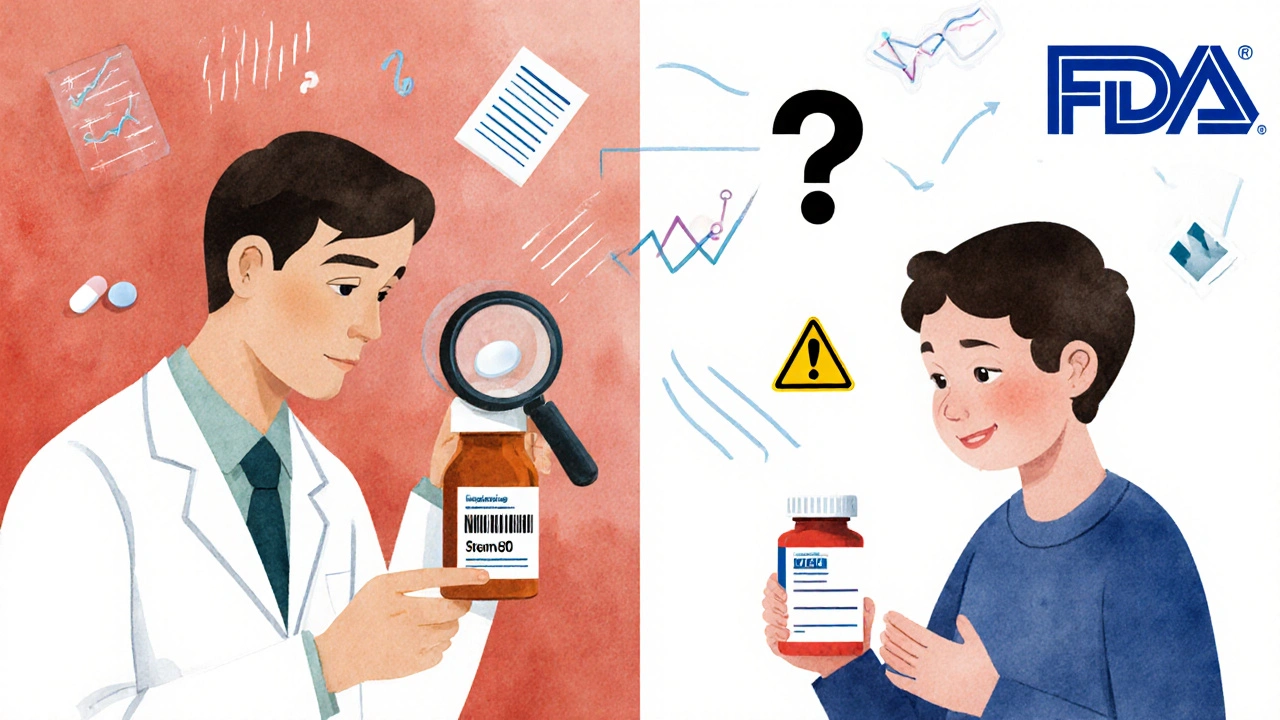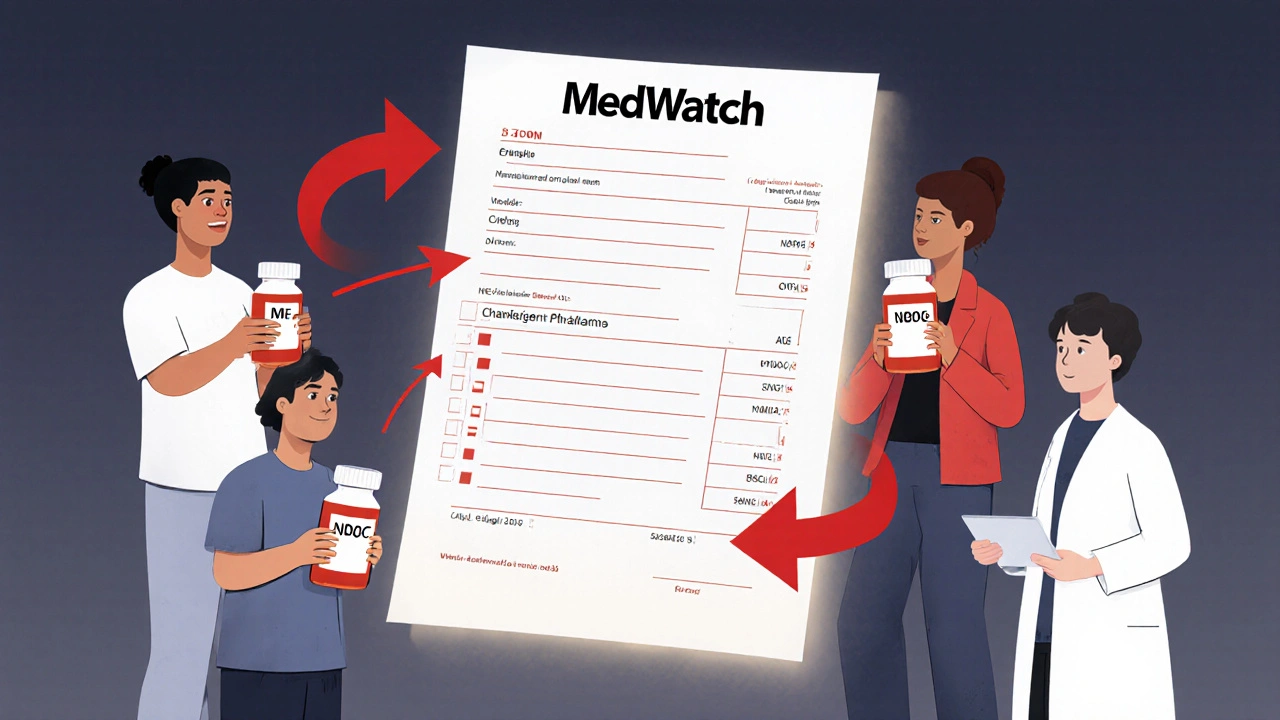When you pick up a generic pill from the pharmacy, you expect it to work just like the brand-name version. But what happens when it doesn’t? What if you feel worse, or the medicine just doesn’t seem to help anymore? That’s where MedWatch reporting comes in - the quiet, behind-the-scenes system that helps the FDA track problems with generic drugs after they hit the market.
How MedWatch Works for Generic Drugs
MedWatch is the U.S. Food and Drug Administration’s official system for collecting reports about unsafe or poorly performing drugs, including generics. It’s not a mandatory system - it relies on people to speak up. Doctors, pharmacists, nurses, and even patients can submit reports when something goes wrong. For generics, this is especially important because they make up about 90% of all prescriptions filled in the U.S., but they’re often treated as interchangeable without enough scrutiny.The system collects data through two main paths: online via the FDA’s MedWatch portal, or by filling out Form FDA 3500 by hand. Both methods ask for the same core details: the name of the drug, what happened, when it happened, and who reported it. But here’s the catch - for generics, the form doesn’t always make it easy to say which generic you took.
The Problem with Generic Identification
One of the biggest hurdles in tracking safety for generics is that most reports don’t include the manufacturer’s name. In fact, data from 2020 to 2024 shows that only about 33% of reports involving generics included the specific company that made the drug. Compare that to brand-name drugs, where nearly 90% of reports name the manufacturer.Why does this matter? Because not all generics are created equal. Even though they’re required to be bioequivalent - meaning they deliver 80% to 125% of the active ingredient as the brand - small differences in inactive ingredients, coating, or manufacturing can cause real-world problems. Patients have reported issues like sudden mood swings with generic sertraline, or seizures returning with a different batch of levothyroxine. These aren’t just random side effects. They’re signals that a particular generic version might not be working the same way for everyone.
Pharmacists and doctors often know which manufacturer made the drug because they see the National Drug Code (NDC) on the packaging. But patients? Most don’t even know what NDC means. And when they try to report a problem, the MedWatch form just says “generic sertraline” or “generic metformin.” No manufacturer. No batch number. Just a name.
Therapeutic Inequivalence: The Silent Issue
The FDA has a specific category in MedWatch for something called “therapeutic inequivalence” - when a generic drug doesn’t work the same way as the brand or a previous generic version. This isn’t about allergic reactions or overdoses. It’s about the medicine failing silently: your blood pressure doesn’t drop, your depression doesn’t lift, your seizures return.A 2022 study found that patient concerns about therapeutic failure in generics rose by 37% between 2020 and 2023. One of the most documented cases involved a specific generic version of bupropion XL made by Mylan. Multiple patients reported a sudden return of depressive symptoms. Doctors noticed the pattern. When enough reports came in, the FDA launched an investigation. Within 11 months, the label was updated to include a warning about potential therapeutic failure with that specific product.
That’s the power of MedWatch - when enough people report the same issue, it triggers action. But only if the data is clear enough to trace back to the source.

Who Reports and Why It’s Hard
Healthcare professionals are the most consistent reporters. A 2024 survey found that 96% of physicians found the MedWatch form easy to use. But even they struggle. Seventy-eight percent said they had trouble distinguishing between generic manufacturers in the system. Many don’t know which company made the drug their patient took unless they check the pharmacy’s records.Patients face even bigger barriers. A 2023 FDA analysis showed that 63% of consumer reports didn’t include the manufacturer because patients simply didn’t know. The pill bottle might say “Sertraline 50 mg,” but the manufacturer’s name is printed in tiny font on the side. Most people don’t look. And even if they do, the MedWatch form doesn’t have a dedicated field to enter it.
Pharmacists, who see the NDC codes daily, are often the best source of accurate data. But they’re stretched thin. A 2024 survey by the American Society of Health-System Pharmacists found that 71% of pharmacists said they didn’t have time to complete detailed MedWatch reports, even when they saw a pattern.
What’s Being Done to Fix It
The FDA knows this is a problem. In 2024, they rolled out a new algorithm that can now identify generic drugs in reports with 92% accuracy by analyzing patterns in drug names, dosages, and associated symptoms. This doesn’t fix the reporting form - but it helps them sort through the mess after the fact.The Generic Drug User Fee Amendments (GDUFA) III plan, launched in 2023, includes a promise to improve how generics are tracked. One big step coming by 2026 is direct integration with electronic health records. That means when a doctor prescribes a generic, the system will automatically capture the NDC code and manufacturer - no manual entry needed. That could cut reporting errors by more than half.
The FDA has also started offering Spanish-language reporting forms and training modules for pharmacists. These aren’t flashy fixes, but they’re practical. They meet people where they are - in the pharmacy, in the clinic, at home with a bottle of pills.

What You Can Do
If you’ve noticed a change in how a generic drug works for you - whether it’s less effective, new side effects, or symptoms returning - don’t ignore it. Here’s how to report it properly:- Check the pill bottle for the manufacturer name and NDC code (it’s usually on the side or bottom).
- Go to www.fda.gov/MedWatch and click “Report a Problem.”
- Enter the generic drug name first, then add “generic” and the manufacturer name if you know it.
- Describe exactly what happened: “I switched from brand-name levothyroxine to this generic in March. My TSH levels jumped from 2.1 to 8.9 in 6 weeks.”
- Include your age, sex, and any other medications you’re taking.
- Submit. Even if you don’t get a reply, your report goes into the system.
It’s not glamorous. It doesn’t make headlines. But every report adds a piece to the puzzle. In 2022, a single pharmacist submitted 17 reports about generic levothyroxine. One of them led to a label change. That’s how change happens - one report at a time.
Why This Matters Beyond the U.S.
The U.S. isn’t the only country dealing with this. The European Medicines Agency’s EudraVigilance system has had better generic tracking since 2022 because they require manufacturers to include unique identifiers in every report. The U.S. is catching up, but slowly. Right now, MedWatch is still the main tool for spotting problems with generics here - and it only works if people use it.Generic drugs save the U.S. healthcare system over $300 billion a year. But savings shouldn’t come at the cost of safety. If you’re taking a generic, you’re not just a patient - you’re part of the safety net. Your voice matters. Your report could help someone else avoid a bad reaction. Or even prevent a recall.
Can I report a problem with a generic drug even if I’m not sure it’s the medication?
Yes. You don’t need to be certain. The FDA’s job is to investigate patterns. If multiple people report similar issues with the same generic drug, even without absolute proof, it can trigger a safety review. It’s better to report and let experts analyze the data than to stay silent.
Do I need to report every side effect I experience?
No. Focus on serious or unusual reactions - especially those that are new, unexpected, or significantly different from what you experienced with the brand-name version. Common side effects like mild nausea or dizziness are usually expected and don’t need reporting unless they’re severe or persistent.
What if I don’t know the manufacturer of my generic drug?
You can still report. Just enter the generic name and note that the manufacturer is unknown. The FDA will still include your report in the database. If enough people report the same issue without a manufacturer, it can still raise a red flag - especially if it’s linked to a specific pharmacy or batch.
How long does it take for the FDA to act on a MedWatch report?
There’s no set timeline. Most reports are reviewed within weeks, but action takes longer. It often requires multiple reports of the same issue before the FDA investigates. In cases like the Mylan bupropion XL example, it took about 11 months from the first report to a label change. Patience is part of the process.
Can I report a problem for someone else, like a family member?
Yes. You can report on behalf of a loved one, especially if they’re elderly, disabled, or unable to report themselves. Just indicate that you’re reporting for another person and provide as much accurate information as you can about their experience.


Bill Camp
November 19, 2025 AT 19:50This system is a joke. We let foreign factories make our meds with no oversight and then wonder why people get sick. The FDA's too busy kissing pharma butt to crack down on the real culprits. I've seen generics that look like chalk dust. If you're taking one, you're gambling with your life.